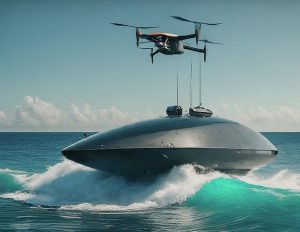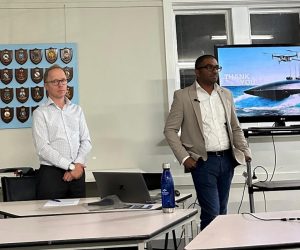Technical Presentation –– 17 April 2024
Nirman Jayarathne, Innovation Group Lead, Navantia Australia, gave a presentation on Navigating the Seas of Innovation at the Mission to Seafarers in Docklands and streamed live via Zoom on 17 April. The presentation was attended by 7, with a further 20 participating online.
Nirman began his presentation by discussing the ‘waves of innovation’ which have occurred over the past 240 years and used this to illustrate how much technology will change over the lifespan of a ship being designed today. He then went on to define innovation as ‘engineering development towards commercial deployment of a new product’. The emphasis here was that creativity can produce new ideas, but they only count as innovation once they achieve commercial deployment.
Nirman posed the question “Who can innovate?”. He proposed, somewhat contentiously (though drawing on the research of others), that ‘recognised expertise’ is required for purposeful creativity. He explained that novel or creative ideas can come from anyone, but the quality which leads to useful innovations is far more likely to come from people with expertise.
Nirman explained how research has shown that teams where everyone thinks in similar ways are less successful at innovating. These teams are said to have a high level of interconnection. He proposed that “for faster breakthroughs in maritime innovation, cross-functional, multidisciplinary teams with intermediate levels of interconnection should be created.” To demonstrate this, Nirman explained how the Ukraine has become very successful at developing new maritime drones very quickly in their war with Russia, due to a wide range of people with different skill sets having joined the Ukraine military since the conflict began.
Nirman explained the difference between people who are ‘adaptors’ versus those who are ‘innovators’. In summary, adaptors seek to do things better, whereas innovators seek to do things differently. To be realistic, in engineering professions we probably need a mix of both. As an example of adaptors, Nirman spoke about the ship design spiral. The spiral will continually improve on a design, but it is not agile enough to allow for real innovation. In addition, the pressure of deadlines will stifle creativity.
Nirman spoke about different tools which are useful for naval architect innovators. He listed mathematical problem-solving, Quintilian’s Seven Questions, teleological decomposition, accelerated radical innovation (ARI), Osborn-Parnes Creative Problem-Solving Process, MUDA, TRIZ, brainstorming, Amazon Method, SCAMPER Method, multitasking, synectic, and design-by-analogy.
Nirman wrapped up his presentation by emphasising that innovation is often perceived as being through complex and advanced systems but, really, we should strive for simplicity. As an example, with the proliferation of unmanned vessels, the simpler we can keep them, the more reliable they will be.
Finally, there was a discussion about artificial intelligence (AI), prompted by how he had used Google Gemini to create the image used in the flier promoting the talk. We were left with the tantalising thought that, in the future, rather than using prompts for AI to create images, we may be using prompts from which an AI-driven shipyard will autonomously build a ship.
The presentation provoked a good number of questions and discussion at the end.
The presentation was recorded and is expected to be available soon ***(pending Navantia approval)*** on the RINA YouTube channel.
AI-generated maritime innovation
(Image courtesy Nirman Jayarathne)
The Presenter
Nirman is a naval architect with 18 years of experience in various roles in the maritime industry, including ship management, commercial and naval ship design, marine surveying, lecturing, commercial and defence research, and leading innovation projects. He completed his PhD in ship-to-ship interaction in 2018 at the Australian Maritime College. Currently as the Innovation Group Lead at Navantia Australia, he is responsible for driving the development of new and innovative technologies and solutions for the naval defence sector. His research interest focuses on the application of AI for naval ship and system designs and ship hydrodynamics. He has led teams which developed a novel uncrewed landing craft (ULC) concept and uncrewed-RHIB projects at Navantia Australia.
Tom Dearling (L) and Nirman Jayarathne
(Photo courtesy Johnson Joseph)
Technical Presentation –– 21 March 2024
Jacob Bailey, Lead Project Engineer for Austal’s Patrol Boat Autonomy Trial (PBAT), gave a presentation on Lessons from Medium-USV Trials: Building Trust in Platform Autonomy streamed live via Zoom on 21 March. The presentation was attended by 21 participating online.
Jacob began his presentation by describing what platform autonomy is and how it expands in complexity between small to large unmanned surface vessels (USVs). He then introduced the attendees to medium-to-large USVs (M-LUSVs) which formed the focus of the presentation since their capabilities cannot be met by smaller USVs. The presentation highlighted challenges associated with M-LUSVs such as complexity, cost, availability and reliability.
Jacob then discussed how the PBAT programme was developed to demonstrate the capability of M-LUSVs to the Royal Australian Navy. Within the program, platform and navigational autonomy were tested for remote operation, autonomous operation, and extended operation which involves traversing up and down the west coast of Australia. During his presentation, Jacob discussed some of the challenges with autonomy, including building reliability and developing trust. The presentation was well received and generated significant questions and discussion.
The presentation was recorded and is expected to be available soon ***(pending Austal approval)*** on the RINA YouTube channel
Sentinel (ex-HMAS Maitland) in the Patrol Boat Autonomy Trial
(Photo from navalnews.com website)
The Presenter
Jacob started his professional career over six years ago at Austal as a graduate engineer and has spent his career contributing to the marine industry with a passion for novel technology that advances the field. He has been responsible for various roles across new-build and R&D projects, from large 118 m commercial trimarans to 60 m patrol boats for the Royal Australian Navy.
Jacob is the lead project engineer for Austal’s Patrol Boat Autonomy Trial (PBAT). This project has navigated the technical and regulatory challenges with retrofitting and certifying an existing 56 m patrol vessel from manned to unmanned. PBAT has been retrofitted with a navigational autonomy system to navigation according to COLREGs and a platform autonomy system to operate key systems to enable extended endurance without crew intervention.




